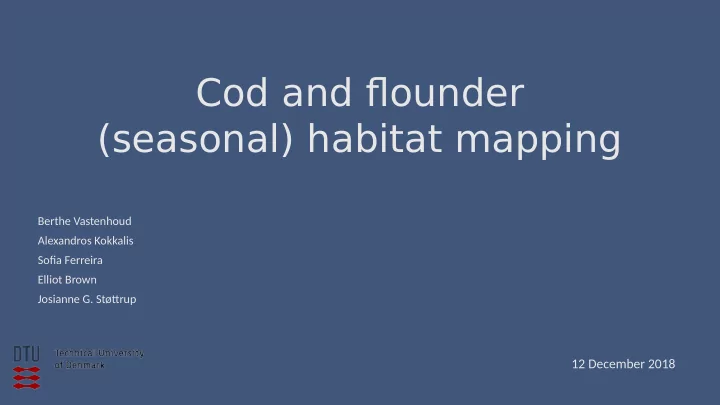

Cod and fmounder (seasonal) habitat mapping Berthe Vastenhoud Alexandros Kokkalis Sofja Ferreira Elliot Brown Josianne G. Støturup 12 December 2018
Map fjsh habitats to contribute to the FishHab II project knowledge basis for Maritjme Spatjal Planning 10 commercially important species in the inner Danish waters
Objectives Mapping of habitats Explore seasonality of the spatjal distributjons, relatjve to life stage (juvenile, adult) habitats
6 maturity stages 1. Virgin - Immature KASU dataset 2. Maturing - Mature Danish part of Baltjc Internatjonal Trawl Survey (BITS) 3. Spawning - Mature • Number of individuals per length 4. Spent - Mature Separate analysis juveniles/adults 5. Restjng- Mature • 1994-2017 6. Abnormal - Mature Sampled twice a year Q1 : February/March Q4 : October/November/December Fitued maturatjon ogive Additjonal sampling campaign in 2016 (Q3) SEASONAL DISTRIBUTIONS 2005 – 2015: checked to validate 2016
Distributions • Seasonal • Physical characteristjcs • Temperature Habitat distributjon models: • Oxygen • identjfy factors infmuencing species' • Salinity occurrence • Current speed • visualize the spatjal arrangement of • Sediment type habitats • Biological characteristjcs • Food • Predatjon
Modeling Number of individuals (Separate models for juveniles and adults) Environmental factors • Temperature • Oxygen Generalised Additjve Models (GAMs) • Salinity • Current speed • Depth Main model including all possible (environmental) variables, reduce • Sediment type stepwise removing the least signifjcant variable untjl all are signifjcant Spatjotemporal factors Ofgset efgort • Quarter • Seasonal component • Sampling positjon
Adults
Results - Adults Signifjcant variables: • Salinity • Oxygen • Temperature • Quarter Quantjles: cut points dividing the range of observatjons into intervals with equal probabilitjes
Uncertainty - Adults
Spawning: Q1 (& Q2) in the Katuegat and the Sound • north of Læsø • southern Katuegat including Skälderviken and Laholmsbugten • Great Belt Western Baltjc stock: Kiel Bight ? Declining stock: many of the earlier spawning sites are no longer observed & changed to: • ofg the coast of Falkenberg • very close to the entrance to the Sound (Vitale et al., 2008; Börjesson et al., 2013)
Can we use 2016 as an example for other years? Model for 2005-2015 Similar selectjon process to 2016 model Predict numbers at statjons in 2016 Compare • Center of mass Average of weighted positjon coordinates of the distributed mass • standard deviatjon ellipse (SDE) Dispersion of weighted point observatjons along two orthogonal axes
Juveniles
Results - Juveniles Signifjcant environmental variables: • Salinity • Oxygen • Temperature • Depth • Quarter
Uncertainty - Juveniles
Results - Juveniles Associated to habitats that provide refuge (greater structural complexity than sand/mud) • Sediment type not signifjcant • Too few observatjons in coarse substrate/mixed sediment • Quality sediment data could be improved Other studies: • Surface salinity • Depth • Temperature < 16°C
Can we use 2016 as an example for other years? Compare • Center of mass Average of weighted positjon coordinates of the distributed mass • standard deviatjon ellipse (SDE) Dispersion of weighted point observatjons along two orthogonal axes
Adults vs. Juveniles JUVENILES ADULTS
Conclusions What has been done? • Mapping habitats and exploring seasonal distributjons • Difgerences between seasons and between juveniles and adults • Modeling based only on one year (2016) • Fittjng a model for the years 2005-2015 predicts 2016 quite well Next steps ● Extend analysis spatjally and temporally ● Improve modeling of spatjal auto-correlatjon (e.g. LGCP model) ● Length-based model
Flounder - Adults
Results - Adults Signifjcant variables: • Salinity • Depth • Temperature • Quarter Quantjles: cut points dividing the range of observatjons into intervals with equal probabilitjes
Uncertainty - Adults
Flounder - Juveniles
Results - Juveniles Signifjcant variables: • Sediment type • Oxygen • Temperature • Depth • Quarter
Uncertainty - Juveniles
Recommend
More recommend